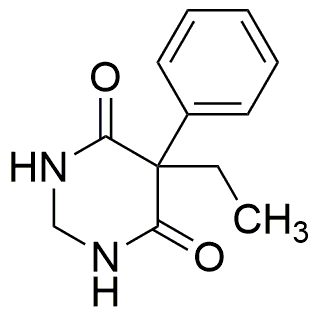Primidone is widely utilized in research focused on:
- Epilepsy Treatment: Primidone is primarily used as an anticonvulsant medication to manage epilepsy, particularly in patients who do not respond to other treatments. It helps reduce the frequency of seizures, improving the quality of life for many individuals.
- Essential Tremor Management: This compound is effective in treating essential tremors, a condition characterized by involuntary shaking. Its ability to stabilize muscle control makes it a valuable option for patients seeking relief from this condition.
- Research in Neurology: In clinical studies, Primidone is often investigated for its neuroprotective properties, helping researchers understand its mechanisms and potential applications in other neurological disorders.
- Combination Therapy: Primidone is frequently used in conjunction with other anticonvulsants to enhance seizure control. This combination approach allows for tailored treatment plans that can be more effective for individual patients.
- Pharmacological Studies: The compound serves as a subject of pharmacological research, helping scientists explore its interactions and effects on the central nervous system, which can lead to the development of new therapeutic strategies.
General Information
Properties
Safety and Regulations
Applications
Primidone is widely utilized in research focused on:
- Epilepsy Treatment: Primidone is primarily used as an anticonvulsant medication to manage epilepsy, particularly in patients who do not respond to other treatments. It helps reduce the frequency of seizures, improving the quality of life for many individuals.
- Essential Tremor Management: This compound is effective in treating essential tremors, a condition characterized by involuntary shaking. Its ability to stabilize muscle control makes it a valuable option for patients seeking relief from this condition.
- Research in Neurology: In clinical studies, Primidone is often investigated for its neuroprotective properties, helping researchers understand its mechanisms and potential applications in other neurological disorders.
- Combination Therapy: Primidone is frequently used in conjunction with other anticonvulsants to enhance seizure control. This combination approach allows for tailored treatment plans that can be more effective for individual patients.
- Pharmacological Studies: The compound serves as a subject of pharmacological research, helping scientists explore its interactions and effects on the central nervous system, which can lead to the development of new therapeutic strategies.
Documents
Safety Data Sheets (SDS)
The SDS provides comprehensive safety information on handling, storage, and disposal of the product.
Product Specification (PS)
The PS provides a comprehensive breakdown of the product’s properties, including chemical composition, physical state, purity, and storage requirements. It also details acceptable quality ranges and the product's intended applications.
Certificates of Analysis (COA)
Search for Certificates of Analysis (COA) by entering the products Lot Number. Lot and Batch Numbers can be found on a product’s label following the words ‘Lot’ or ‘Batch’.
*Catalog Number
*Lot Number
Certificates Of Origin (COO)
This COO confirms the country where the product was manufactured, and also details the materials and components used in it and whether it is derived from natural, synthetic, or other specific sources. This certificate may be required for customs, trade, and regulatory compliance.
*Catalog Number
*Lot Number
Safety Data Sheets (SDS)
The SDS provides comprehensive safety information on handling, storage, and disposal of the product.
DownloadProduct Specification (PS)
The PS provides a comprehensive breakdown of the product’s properties, including chemical composition, physical state, purity, and storage requirements. It also details acceptable quality ranges and the product's intended applications.
DownloadCertificates of Analysis (COA)
Search for Certificates of Analysis (COA) by entering the products Lot Number. Lot and Batch Numbers can be found on a product’s label following the words ‘Lot’ or ‘Batch’.
*Catalog Number
*Lot Number
Certificates Of Origin (COO)
This COO confirms the country where the product was manufactured, and also details the materials and components used in it and whether it is derived from natural, synthetic, or other specific sources. This certificate may be required for customs, trade, and regulatory compliance.


